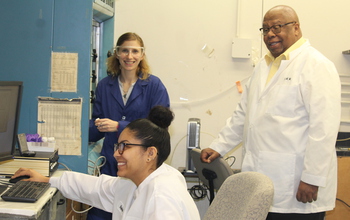All Images
Research News
Remarkable ‘electronic nose’ could sniff out nerve gas and rotten foods simultaneously

Isiah Warner and his group members use a group of uniform materials based on organic salts, called GUMBOS, as sensing materials to identify the type and quantity of volatile organic compounds that produce multiple odors.
Credit: Mark Landry, Louisiana State University
Download the high-resolution JPG version of the image. (5.3 MB)
Use your mouse to right-click (Mac users may need to Ctrl-click) the link above and choose the option that will save the file or target to your computer.

Isiah Warner and his team use a tool called a quartz crystal microbalance (QCM) to determine the weight of molecules that compose gases, or volatile organic compounds (VOCs), that produce odors. This is a miniaturized version of it. A CQM works like a highly sensitive balance that can report the mass of a tiny amount of absorbed material. It consists of a thin quartz wafer coated with modified GUMBOS sandwiched between a pair of metal electrodes. When voltage is applied across the two electrodes, the quartz wafer vibrates. Changes in vibration or frequency indicate the mass of the absorbed material, while the GUMBOS identify the type and quantity. Collaborative inventor Jin-Woo Choi is working to miniaturize the CQM for use outside the laboratory.
Credit: Mark Landry, Louisiana State University
Download the high-resolution JPG version of the image. (230.2 KB)
Use your mouse to right-click (Mac users may need to Ctrl-click) the link above and choose the option that will save the file or target to your computer.


